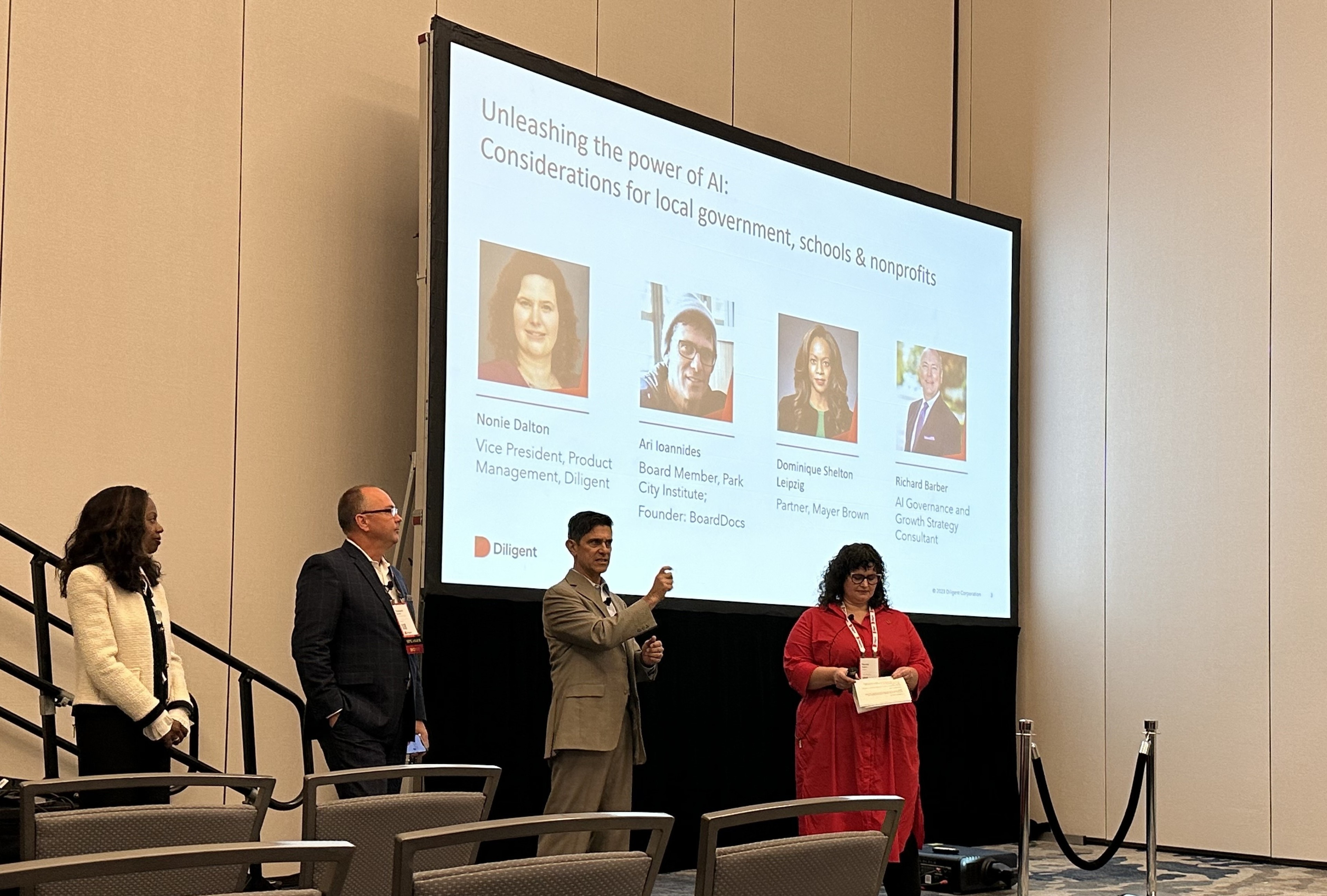Public leaders share their thoughts on AI

AI adoption in the public sector continues to grow, but cautiously, with communications use cases leading the push, according to a recent survey of public leaders by Diligent. By comparing Diligent’s 2024 survey results, we see trends that show that while adoption has increased, there is hesitation.
Key insights from the AI survey of public leaders
The survey surfaced several trends among public leaders:
- 57% have adopted AI to some extent in their organizations.
- AI hesitation has grown to 37% compared to last year’s 16%.
- Operational efficiency remains the primary realized benefit of AI.
- Over half of respondents cite using AI for communications, the top use case.
- The importance of ethical issues around AI has declined, while data and security remain top concerns.

AI adoption has grown, but so has hesitancy
In 2025, 57% of public sector organizations have adopted AI either in limited areas or throughout their organization (40% limited, 17% throughout), with a further 28% still considering adoption. This marks a small increase in widespread adoption compared to last year, when 52% had implemented AI in some capacity.
Meanwhile, the proportion of organizations undecided or resistant to AI has grown to 37% (28% are “thinking of doing so,” with 9% indicating “no and don't think we will”), compared to only 16% last year reporting no plans or uncertainty.
With AI having such a hold on for-profit enterprise, it’s noteworthy that adoption and consideration for the public sector continue to be more modest. However, given increased levels of hesitation indicated in other parts of the survey, it’s not unexpected. One respondent noted that their organization was “avoiding it as much as possible,” while another cited their biggest challenge as “ensuring that staff who haven't been approved to use AI are not using it.”
AI cautionary tales are gaining a greater foothold in the media, and public leaders should be aware of issues around results accuracy and sustainability. Thoughtful use of AI retains human oversight. Teams should pay careful attention to positive use cases to ensure they realize benefits for their staff and communities.
Communications claims over half of AI use
AI’s top use in 2025 amongst public sector organizations is for communications (52%), reflecting a continued emphasis on supporting routine messaging and administration. One respondent specifically noted using AI for “clarifying emails.” Routine task automation (28%) and chatbots (23%) also are cited, with a small but active segment also exploring data analysis and reporting and program evaluation. This trend broadly mirrors last year’s results, though “innovation” as a driver has moved down the list.
For public sector organizations, the time savings realized with AI-supported tasks — from generating meeting minutes and report summaries to producing data summations — can free up time for more strategic public service work.
Efficiency still reigns, but fewer report benefits
Organizations cite increased operational efficiency as the primary benefit of AI (46%), broadly in line with 2024's findings (50%). Notably, a significant 36% in 2025 say they are not using AI actively, suggesting that after initial excitement, the practical impact for many remains limited. “Enhanced customer experience” and “innovation” are considerably less prevalent as reported outcomes versus last year.
“Efficiency” remains the primary keyword around AI. For officials and staff who have rote tasks to accomplish through their workdays, it’s an obvious desired benefit. From transcribing meetings and generating minutes to processing survey results, AI tools speed work and move contributors to decision-making much faster. However, other survey answers shine a light on why more respondents aren’t realizing these benefits.
Privacy and security concerns stay high, while many simply resist change
Data privacy and security (43%) remain the top concern, just as in 2024. However, resistance to change (39%) and ethical/regulatory issues (34%) have increased sharply, surpassing concerns around integration and cost. Lack of skilled personnel (28%) is a persistent barrier. This points to more “human factors” challenging implementation as technical hurdles begin to subside.
AI has many applications to expedite work and refocus staff efforts. But as with any new solutions, representatives have special considerations. As one respondent notes,
Policy adoption still lags, inviting risk
Only 27% of organizations reported having formal AI policies or guidelines in 2025 — virtually unchanged from 2024 (28%), so the policy gap persists even as adoption increases. A striking 45% have no policy; nearly a third are unsure, underscoring confusion or lack of clarity about governance responsibilities.
As with all issues facing local governments, a lack of policy won’t defray risk. If your organization has yet to finalize your AI positions, the time is now to add it to your agenda and begin collecting research and best practices.
A state- or national-level body may have sample policy materials to advance the discussion. That’s how several respondents started their policy efforts, while another notes that “our tech department director created a collaborative group with other school districts in our county.”
Limited ethics oversight: Stagnation or regression?
Efforts to address AI’s ethical implications have declined: 77% say their organizations haven’t meaningfully addressed responsible AI, compared to 56% reporting no ethics policy last year. Formal ethics training and committee formation remain rare (<15% combined showing surprisingly little progress despite heightened concerns).
Ethical issues related to AI use, from big-picture sustainability questions to the microcosm of copyright ownership, are part of a bigger discussion of how to best incorporate AI into school board and city council work.
Training is an unmet need
Eighty percent of boards received no AI-focused training or education in 2025, up from 58% last year. While some organizations offer sporadic workshops or case studies, most have done little to prepare board members for AI oversight or use.
With its rapid changes and new use cases, AI shouldn’t be a “one and done” topic for training. It’s likely your technology partners are incorporating AI into their offerings, and residents, staff and students are finding new ways to problem-solve with these technology tools. Ensure new technologies are a regular item on the governing body’s agenda.
If they’re not already, discussions and decisions about AI use will be a regular part of the city’s or school board’s work. Diligent has developed frameworks for local governments and public education to support these conversations.
Diligent continues not just to monitor changing ideas around AI, but to find secure ways to incorporate best-in-class AI into our solutions for public facing boards.
Keep exploring

Unleashing the power of AI for local government and public education
In a recent Diligent panel discussion, industry experts explored how AI can be harnessed to drive positive change and innovation in these sectors

How AI is transforming public and nonprofit governance from reactive to proactive
Listen to how AI is transforming governance for nonprofits and public sector boards, boosting impact, efficiency and ethical decision-making.

Experts share top tips for AI governance for mission-driven organizations
We asked experts from multiple fields to tell us how mission-driven organizations can responsibly govern the use of artificial intelligence